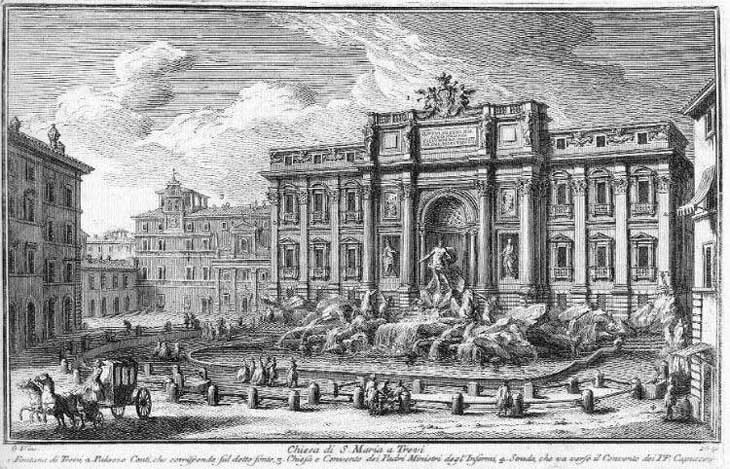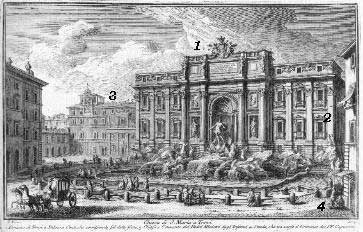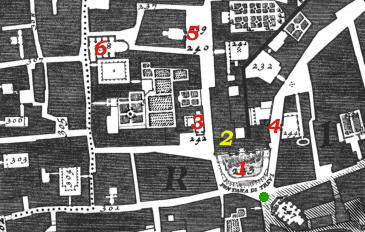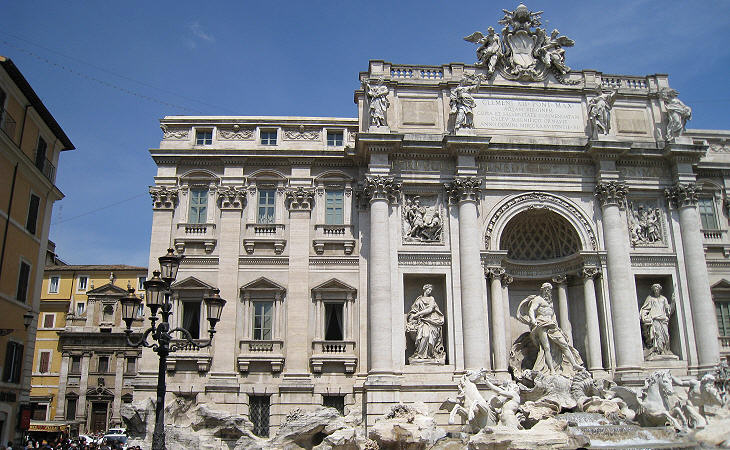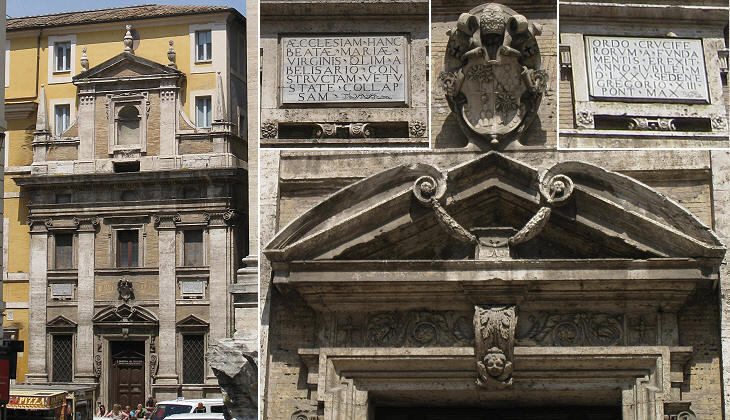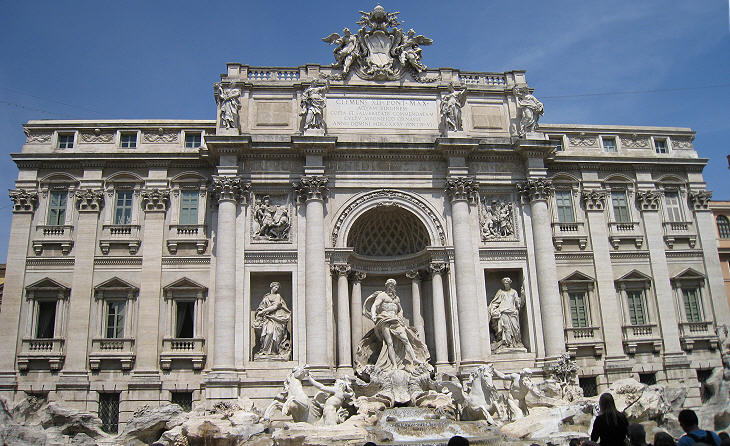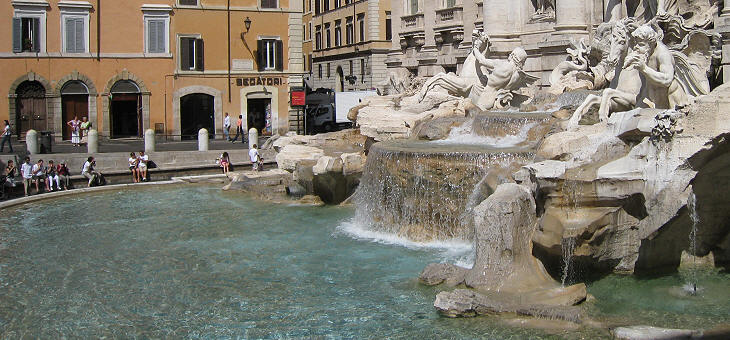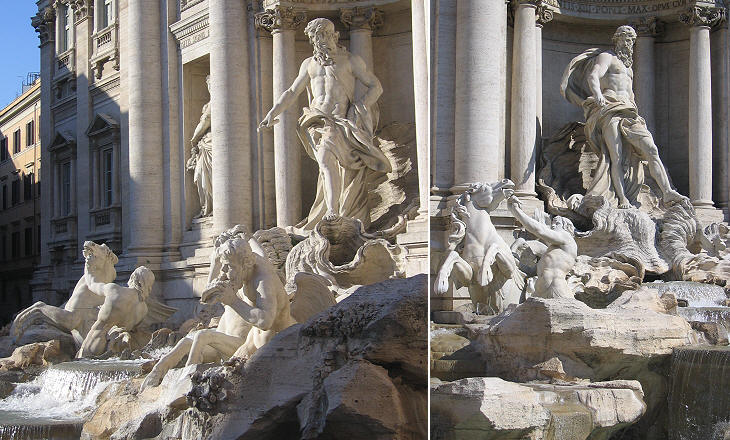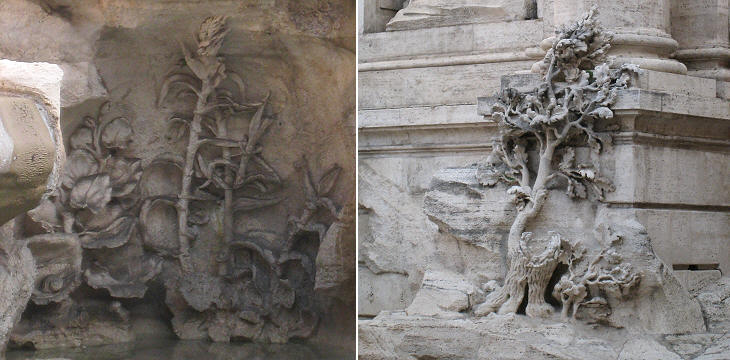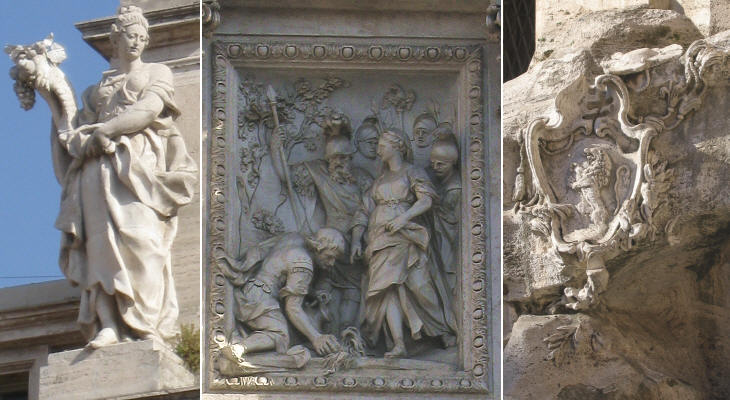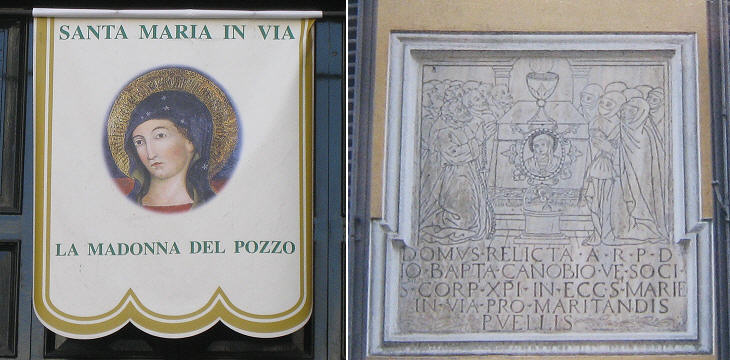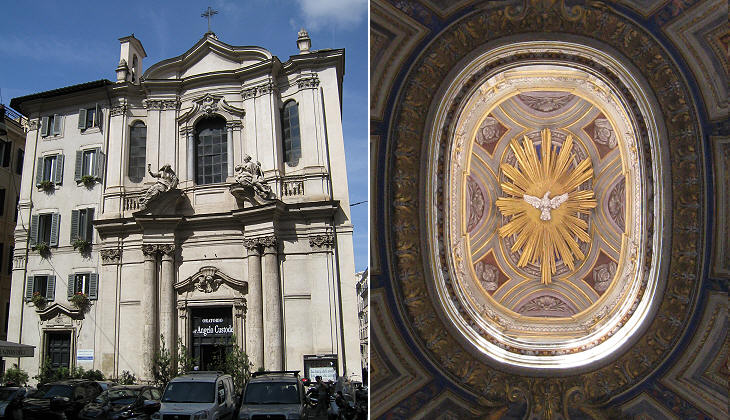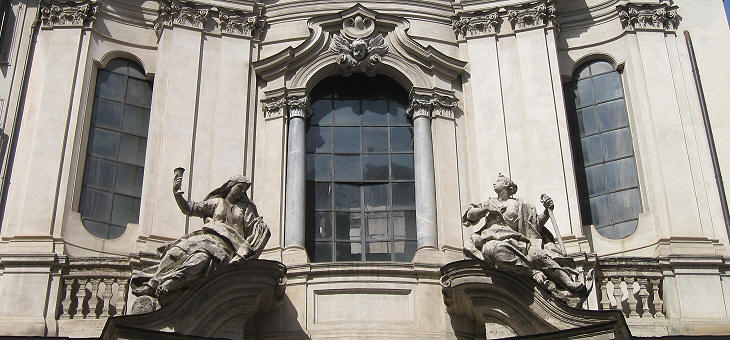  What's New! Detailed Sitemap All images © by Roberto Piperno, owner of the domain. Write to romapip@quipo.it. Text edited by Rosamie Moore. Page revised in June 2009. | S. Maria in Trevi (Book 6) (Map B2) (Day 3) (View C7) (Rione Trevi)
In this page:
S. Maria in Trivio (three streets) is the "official" subject of the plate. The Fountain of Trevi was not yet fully completed at the time Vasi printed this plate in 1756, but he preferred to show it with all the statues already in place. The view is taken from the green dot in the small 1748 map here below. In the description below the plate Vasi made reference to: 1) Fontana di Trevi; 2) Palazzo Conti; 3) S. Maria a Trevi; 4) Street leading to Convento de' Padri Cappuccini. The small map shows also 5) Oratorio del SS. Sacramento; 6) S. Maria in Via.
Today
Very little has changed and one can still notice the church to the left of the fountain. By comparing the plate with the actual fountain it is possible to notice that the two statues (Salubrity and Fecundity by Filippo della Valle) at the sides of Ocean do not match those shown by Vasi. S. Maria in Trivio
S. Maria in Trivio is one of the oldest churches of Rome; according to tradition it was founded by Belisarius, the Byzantine general who conquered Rome twice in the VIth century. According to an XIth century inscription on the side wall of the church he did so to expiate his wrongdoings; this episode is remembered in another inscription placed on the façade. The church was almost entirely rebuilt for the 1575 Jubilee year by Jacopo del Duca. The coat of arms of Pope Alexander VII was added in 1667 when the church was assigned to another religious order. You can see the fine ceiling of the church in a page covering the ceilings of many Roman churches.
Fontana di Trevi
Fontana di Trevi was the terminal point of an ancient Roman aqueduct which was built by Marcus Vipsanius Agrippa (Emperor Augustus' son-in-law) to supply water to the baths named after him. The aqueduct lay underground for most of its length: it came to the surface near Collegio del Nazzareno where some of its arches are still visible. It was restored by Pope Nicholas V in 1453 and again in the following century. It ended with a large basin designed by Gian Lorenzo Bernini for Pope Urban VIII: it was paid for with a tax levied on wine.
Several popes considered the idea of building a monumental fountain similar to those of Acqua Felice and Acqua Paola, but little was done until Cardinal Michelangelo Conti was elected Pope Innocent XIII in 1721. His family owned the palace near the basin and the construction of a fountain was regarded as an addition to its importance. Pope Innocent XIII passed away after just two years and the project was shelved until 1730 when it was resumed by Pope Clement XII whose gigantic coat of arms by Paolo Benaglia is placed at the top of the fountain.
Pope Clement XII was personally involved in choosing the design of the fountain and its decoration; it is interesting to note that the project by Nicola Salvi that he endorsed is totally free of religious connotations; the main statue portrays Ocean, but only those very familiar with traditional iconography can tell that it does not portray Neptune, the pagan God of the Sea. The pope showed his pragmatism also in reintroducing the game of lotto to finance the construction of the fountain. Its overall design recalls that of a Roman triumphal arch and the two tritons acting as horse tamers are a reminder of Castor and Pollux, the twin demi-gods who protected Ancient Rome.
The basic structure of the fountain was completed in 1742, but its decoration was completed only in 1762 when the formal inauguration took place. The best sculptors were asked to embellish the fountain with their works. They had however to comply with a detailed design, in particular Pietro Bracci had to follow a plaster model by Giovanni Battista Maini. The influence of Bernini's Fontana dei Quattro Fiumi with its blend of nature and architecture is evident.
One of the two reliefs portrays a young woman indicating the spring to thirsty soldiers: it explains the traditional name (Aqua Virgo/Acqua Vergine) given to the water carried by the aqueduct. Pope Benedict XIV rewarded in an unusual way Monsignor Giancostanzo Caracciolo di Santobono who was in charge of the completion of the fountain: he allowed him to have his coat of arms placed among the rocks on the right side of the fountain. Palazzo Poli consisted of several buildings which were in part pulled down and modified when Via del Tritone, the street linking Piazza Colonna with Piazza Barberini, was enlarged. S. Maria in Via
The church is very old and most likely owes its name to the fact that it was near the urban section of ancient Via Flaminia which later on was called Via del Corso. The current building is a result of a series of additions and modifications which started in 1576 and ended more than a century later with a new façade designed by Carlo Rainaldi. The interior was poorly modified in the XIXth century, leaving only a few elements of the original decoration. American visitors may be interested in observing the complex coat of arms of Cardinal Patrick Joseph Hayes: he was of very humble origin and he probably was over-zealous in his use of symbols when he designed his own coat of arms.
The fame of the church is associated with an event which occurred in 1256 when a nearby well overflowed; the water carried with it a sacred image which was called Madonna del Pozzo (well) and which is worshipped in a chapel of S. Maria in Via. The event is celebrated in a relief placed on an adjoining building which was bequeathed to a brotherhood which met in the church. This in order to support unmarried young women (pro maritandis puellis) by providing them with a dowry.
Oratorio del SS. Sacramento di S. Maria in Via is a fine chapel built in 1728 near the church. The Baroque façade by Domenico Gregorini was completed by two buildings, of which only one is left, because the other was sacrificed to the enlargement of Via del Tritone.
Excerpts from Giuseppe Vasi 1761 Itinerary related to this page:
Next plate in Book 6: S. Lorenzo in Lucina Next step in Day 3 itinerary: Chiesa dei SS. Vincenzo e Anastasio a Trevi Next step in your tour of Rione Trevi: Chiesa dei SS. Andrea e Claudio dei Borgognoni |
